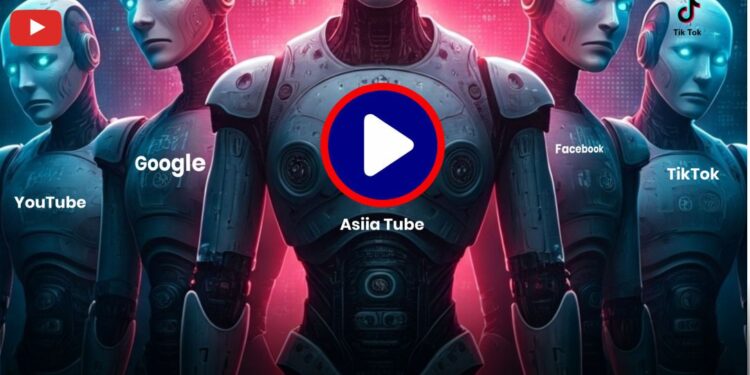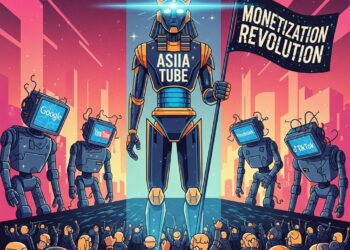In a digital landscape ruled for years by YouTube, Facebook, and TikTok, a new platform is quickly capturing global attention not with gimmicks or celebrities, but with a creator-first philosophy that many have been waiting for. It’s called Asiia Tube, and according to early buzz, it might just force the likes of Google and Meta to revisit their long-standing monetization rules.
Founded by Khurram Shahbaz Malhi, a visionary entrepreneur and digital strategist, and developed under the umbrella of Keekan Technologies, Asiia Tube is a bold response to the frustrations many creators face with traditional platforms. While the giants offer monetization options buried behind walls of eligibility, strict algorithms, and ad-heavy models, Asiia Tube opens the gates for creators of all kinds — from day one.
But how exactly could this change the game for the tech world? And why might Google — the parent company of YouTube — be under pressure to rethink its creator economy?
Let’s break it down.
- Instant Monetization Is the New Benchmark
On YouTube, creators must meet tough thresholds before they’re even allowed to monetize: 1,000 subscribers, 4,000 watch hours, and approval through a manual review process. This barrier prevents millions of emerging voices from earning, even if their content is valuable, original, and engaging.
Asiia Tube, however, changes that. From the moment a creator signs up and verifies their account, they can start earning — whether they post a short video, a blog-style status update, or even just a picture.
This no-barrier entry model may soon become the new standard. Once users realize that they can monetize their content elsewhere without jumping through hoops, platforms like YouTube may be forced to respond or risk losing their creator base.
- Monetizing Regular Posts Is a Game-Changer
While YouTube is all about video and TikTok leans into short clips, Facebook and Instagram revolve around text, images, and basic social posts — which, up until now, haven’t offered any consistent or broad monetization opportunities.
Asiia Tube takes a radical approach by allowing creators to earn from regular posts — yes, even a status update, meme, or motivational quote. Every post’s earning potential is tied to user engagement, time spent, and sharing metrics.
For everyday users, this is revolutionary.
It means you don’t need to be a video editor or performer to earn online. You could be a poet, an educator, or someone who shares inspiring stories — and you’d still get paid.
If this model catches on (and signs show that it already is), Meta may have no choice but to introduce broader monetization tools for all user content — not just videos or reels.
- Open Gifting and Fan Support — Without Gatekeeping
TikTok’s gifting system has been hugely successful in turning casual creators into income earners. But not everyone can access it. TikTok restricts gifting to specific accounts, countries, and follower milestones.
Asiia Tube once again takes the inclusive route. From the very start, creators on the platform can receive gifts and tips from fans during livestreams and video interactions. These gifts have real monetary value and are redeemable through global payment methods, including PayPal, bank transfers, and e-wallets.
This feature alone makes Asiia Tube particularly attractive to creators in emerging markets across Asia, Africa, and the Middle East, where access to monetization has long been limited.
The pressure is now on TikTok and YouTube to remove restrictions and implement more equitable gifting models, or risk losing creators who want quicker and more flexible revenue streams.
- A Policy Model That Puts Creators First
One of the biggest criticisms of big tech platforms is that advertisers come first and creators come second. Algorithms are constantly shifting to favor ad revenue over content value, leaving many creators at the mercy of reach cuts and demonetization without clear explanation.
Asiia Tube, under the leadership of Khurram Shahbaz Malhi, is flipping that model. The platform’s vision is simple: empower creators, not suppress them.
- Content isn’t buried unless it violates clear terms.
- Monetization is transparent — visible through a real-time dashboard.
- Even smaller creators can build sustainable income without “viral” content.
This creator-centric philosophy is one that Google and Meta have long been accused of neglecting. Now, with Asiia Tube gaining ground and trust, the pressure is mounting for tech giants to shift their policies toward fairness, clarity, and inclusiveness.
Built for the World, Not Just One Market
Despite its name, Asiia Tube is not limited to Asia. It’s a truly global platform, welcoming users from every region — and supporting multiple languages and cultural content formats. This sets it apart from platforms that are region-locked or culturally biased in their algorithms.
And because it’s built by Keekan Technologies, a company rooted in both tech innovation and ethical design, the platform integrates global trends with localized awareness, making it friendly to creators often overlooked by mainstream networks.
As a result, creators from Pakistan, India, Bangladesh, Nigeria, Egypt, Turkey, the Philippines, and even Western countries are jumping aboard — and finding monetization options that simply don’t exist elsewhere.
Data-Driven Tools — Without the Complexity
Another area where Asiia Tube outshines the big players is in its creator toolkit.
Rather than flooding users with overly complex dashboards, Asiia Tube offers:
- Real-time analytics (views, earnings, engagement)
- Creator Academy (training modules for new earners)
- Collaboration tools (duets, co-posting, affiliate links)
- Trending insights tailored to niche interests
This approach demystifies earning online — making it accessible for students, hobbyists, part-time creators, and full-time professionals alike.
What Happens Next?
The digital world is evolving. Web 3.0 is about ownership, decentralization, and user empowerment. In many ways, Asiia Tube aligns with that future — even if it’s not blockchain-based.
As creators explore alternatives, platforms like YouTube and TikTok can no longer rely solely on being “first” or “largest.” The new generation of users wants platforms that are fair, fast, and flexible.
Unless Google (via YouTube) adapts to these changing expectations — revising monetization barriers, embracing post-level earning, and loosening algorithmic grip — it may find itself outpaced not by a billion-dollar rival, but by a creator-powered revolution led by Asiia Tube.
Final Thoughts
Khurram Shahbaz Malhi, through Keekan Technologies, has introduced a platform that doesn’t just challenge the status quo — it redefines it.
Asiia Tube is more than a social media app; it’s a signal that the creator economy is shifting toward fairness, accessibility, and immediate reward.
For now, it’s still early — but if current momentum continues, this might be the platform that finally compels Google, Meta, and TikTok to change the rules they once set in stone.
📢 For more updates on digital trends, monetization, and the future of content creation, stay connected with Desert Feed.






